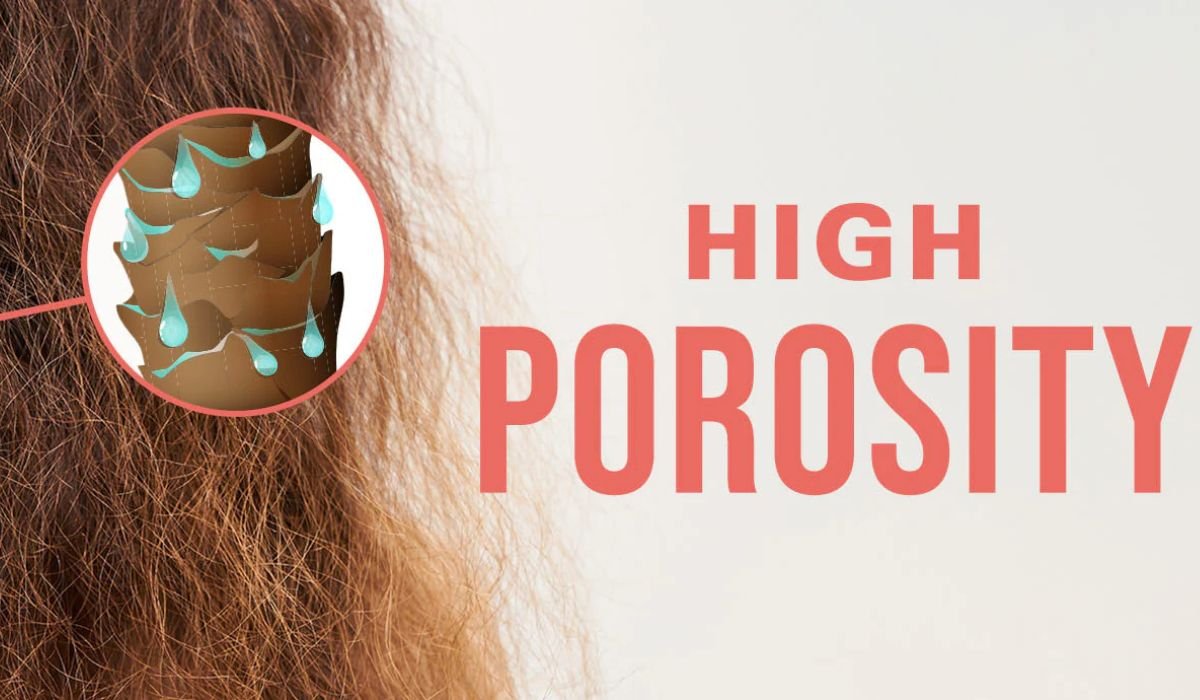High porosity hair can be tricky. It takes in moisture quickly. But it also loses it just as fast. This constant cycle leads to dry, frizzy, and brittle hair. The good news? It’s manageable. You just need the right steps, the right habits, and most importantly, the right products. This guide helps you understand everything about high porosity hair, from causes to care.
If you’ve been struggling with breakage, dullness, or quick-drying hair, this might be your hair type. But don’t worry we’ll show you how to improve it. Whether your hair got this way from heat or coloring, or it’s just how you were born, this is your complete roadmap to restoring softness, moisture, and shine.
What is High Porosity Hair Exactly?
High porosity hair means your hair cuticle has gaps. These gaps let water and oils in fast. But the problem is, it also lets them escape just as fast. That means your hair stays dry even if you moisturize often. The cuticle should be smooth and close together. But in this case, it’s lifted or damaged.
This can happen naturally. It can also be caused by blow drying, bleaching, or too much heat styling. The more damage your cuticle takes, the more porous your hair becomes. The more porous it is, the more care it needs. That’s why having the right routine and using proper high porosity products is so important.
Signs You Have High Porosity Hair
Some hair types absorb water too fast and lose it just as quickly. This section covers common signs that show your hair might be facing trouble keeping moisture in. Pay attention to how your hair behaves each day.
1. Feels Rough or Dry
Hair that always feels coarse or dry may be giving you a signal. No matter how often you apply cream or oil, it never feels soft. This dryness happens even on days you don’t wash it. It may also look dull or lifeless under light.
2. Tangles Very Easily
If your strands knot together even with little movement, it’s a clue. Combing becomes harder. Detangling takes longer. This also causes more breakage. You’ll notice more hair in your brush.
3. Gets Frizzy All the Time
When your hair reacts to moisture in the air, frizz appears fast. It becomes puffy or hard to manage. Even smoothing products don’t always help. This frizz stays around on most days.
4. Breaks Off Often
Does your hair snap while brushing or styling? That’s another sign. Even gentle combing can lead to breakage. Ends split. Strands fall faster than they grow. Growth becomes slow and uneven.
5. Absorbs Products Quickly
You may notice that oil or conditioner disappears fast. It feels like you have to apply more every time. Your hair soaks everything up in seconds. But the results don’t last.
6. Dries Fast After Washing
After a wash, your strands dry faster than expected. You barely need to towel dry. Within minutes, your hair is already dry. This can be a strong clue about how it holds moisture.
Quick At-Home Porosity Test for High Porosity Hair

It’s easy to test how your hair behaves with water. You don’t need any tools or costly kits. This method works best after a fresh wash. Make sure the strand you use is clean and dry.
- Wash and dry your hair.
- Take one clean hair strand.
- Place it in a glass of water.
- Watch it for 2–3 minutes.
Results:
| Result | What It Means |
| Sinks quickly | High porosity hair |
| Floats, then sinks | Medium porosity hair |
| Floats for a long time | Low porosity hair |
If your hair sinks right away, it confirms high porosity hair.
Main Causes of High Porosity Hair
Some hair struggles to keep moisture locked in. The outer layer of the hair strand has small gaps. These gaps let water out fast. Over time, your hair becomes weak, dull, and frizzy. Let’s look at what makes this happen.
1. Overuse of Heat Tools
Hair straighteners and curling irons may look good short-term. But the high heat weakens your strands. The outer layer begins to crack. Each pass of a hot tool removes essential oils. Over time, the damage builds up. Hair becomes fragile and breaks easily.
2. Bleaching or Chemical Treatments
Hair coloring opens the outer layer to let dye in. Repeated coloring causes more harm. Chemicals in bleach strip the hair of its natural defense. Once it’s gone, the hair struggles to stay soft. Frequent coloring leaves hair brittle and lifeless.
3. UV Damage from the Sun
Sunlight is another hidden threat. Long exposure to sunlight dries hair out. The heat from the sun lifts the outer layer. This makes it hard to hold moisture. Beach days feel great, but they come at a cost if your hair is unprotected.
4. Harsh Brushing or Towel Drying
Pulling your hair with a hard brush causes breakage. So does rubbing it dry with a rough towel. Wet hair is soft and stretchy. It needs gentle care. Rough handling makes small cracks even worse. These small cracks turn into serious damage.
5. Product Build-up or Wrong Ingredients
Some products coat your hair instead of helping it. Silicones and alcohols can block moisture. The outer layer gets clogged. Over time, this traps dryness in and keeps hydration out. Choosing the wrong products often adds to the problem.
How to Care for High Porosity Hair
Caring for sensitive hair means treating it gently. Start with the right wash method. Add layers of moisture. End with sealing products. Your goal is to keep water inside the strand. Here’s how you do it right.
1. Use Gentle Shampoo
Pick a cleanser that’s soft and free of harsh chemicals. Washing too often strips your natural oils. Foam isn’t always better. Fewer bubbles often mean less damage. Try washing two to three times a week instead.
2. Add Rich Conditioners
Conditioners help fill the cracks in your strands. Choose thick ones that contain oils or butter. Leave them in for a few minutes. Rinse with cool water to seal the strand. Use every time you wash for best results.
3. Deep Treatments Weekly
Deep masks give your hair extra help. They soak into the layers and rebuild strength. Use one once or twice a week. Let it sit for 20 minutes. Then rinse with cold water. These masks restore softness over time.
4. Limit Styling with Heat
Blow dryers and flat irons can cause harm. Try to air dry your hair more often. If you must use heat, apply a shield first. Keep tools on a low setting. Even short bursts of heat can cause lasting harm.
5. Protect from Sun and Wind
Wear a scarf or hat outside. This keeps the sun from drying your hair. Wind can tangle and weaken strands. If you’re going out for long, apply a light spray before stepping outside. Your hair needs protection too.
Best High Porosity Hair Products for Daily Use
Each day of care matters a lot. Every day, choosing the proper hair products can minimize frizz, hold in moisture and shield hair from harm. Hair tends to become softer and stronger the more often you use a conditioner. We should take a look at what kinds of products are best for habitually using.
Shampoo Options
Pick a good cleanser to be the first step of your beauty routine. Gentle ingredients clean your scalp without removing the natural oils. Check to see if the ones you use improve the health of your skin by keeping it moisturized or fixing it.
Here’s a list of good daily shampoos:
| Product | Key Benefit |
| Devacurl No-Poo Milk Cleanser | Gentle clean, adds moisture |
| L’Oreal Elvive Total Repair Shampoo | Repairs and softens |
| Olaplex No. 4 Bond Maintenance Shampoo | Strengthens weak hair |
These choices suit many hair needs. They also prepare your hair for the next steps.
Conditioner Options
A good conditioner smooths the cuticle. It helps keep moisture in. It also reduces tangles and frizz. Use it right after shampooing.
Here are some solid choices:
| Product | Main Benefit |
| Neutrogena Triple Moisture Conditioner | Deep hydration |
| SheaMoisture Manuka Honey Conditioner | Sulfate-free, rich in oils |
| Silk18 Natural Conditioner | Reduces frizz, adds shine |
These provide hydration and softness. They also help protect against dryness.
Deep Conditioning Treatment
This is a powerful step in your routine. It restores softness and shine. Deep treatments are rich in nutrients. They work best when used once a week.
Some recommended options are:
- SheaMoisture High Porosity Mask – Hemp seed and proteins
- Marc Anthony Grow Long Mask – Argan and keratin boost
Use them on damp hair. Let them sit for 10–15 minutes. Then rinse gently.
Styling Products That Add Protection
Styling without damage is possible. The right products shield strands from heat. They also prevent frizz. Some even offer sun protection.
Top picks include:
- HSI Argan Oil Heat Protectant – Shields from heat tools
- Sun Bum 3-in-1 Leave-In Spray – UV and heat protection
- L’Oreal Blow Dry Cream – Combats frizz before blow drying
Apply these before heat tools. Or use as daily leave-ins for smooth results.
Extra Tips for Better High Porosity Hair Care
Healthy hair care is not just about products. It’s also about habits. Many small steps can help improve your hair’s texture and look. If your strands feel weak or dry, these extra tips might make a big difference. Let’s break them down below.
1. Don’t brush when wet
Brushing wet strands pulls them too hard. This causes breakage. Always wait until your hair is mostly dry. Use a wide-tooth comb instead. Start from the ends and work your way up gently. This prevents damage and reduces tangles.
2. Use a microfiber towel or cotton shirt
Regular towels are too rough. They create friction. That leads to frizz and snapping. Microfiber towels are soft and absorbent. A clean cotton T-shirt also works well. These options are gentler and safer for your strands.
3. Avoid parabens and silicones
Some hair products contain harsh chemicals. These build up over time. They block moisture and weigh the hair down. Look for clean, simple ingredient lists. Natural formulas are better for long-term use. They also help restore shine.
4. Rinse with cool water
Hot water opens the cuticle too much. Cool water closes it gently. That helps seal in moisture. It also makes your strands look smoother. Always finish your wash with a cool rinse. It’s a simple but effective step.
5. Use protective styles often
Leaving your hair open too much can damage it. Wind, sun, and rubbing from pillows take a toll. Try protective styles like braids or buns. These keep your hair safe and tangle-free. Choose loose styles that don’t pull too hard.
How to Grow High Porosity Hair Naturally
Growth takes time and care. Moisture is your best friend here. Use nourishing high porosity hair oils. Seal them in with thick creams. Trim often to remove damaged ends.
Avoid:
- Hot water rinses
- Daily heat styling
- Tight hair ties or clips
Do:
- Sleep on satin pillowcases
- Apply leave-in conditioners
- Use protein masks biweekly
Build a Weekly High Porosity Hair Routine
Creating a set schedule helps maintain moisture and reduce damage. A consistent routine ensures your hair gets the care it needs throughout the week.
| Day | Routine Step |
| Monday | Shampoo + conditioner |
| Tuesday | Moisturize + leave-in conditioner |
| Wednesday | Rest or protective style |
| Thursday | Co-wash if needed |
| Friday | Apply oils + braid hair |
| Saturday | Deep conditioning mask |
| Sunday | Rinse, moisturize, and rest |
Sticking to this kind of weekly plan supports better hair health. It provides hydration, protection, and repair in a balanced way. Over time, you’ll notice less breakage, more shine, and easier styling.
Common Mistakes to Avoid in High Porosity Hair Routine
A solid routine matters, but many people make small mistakes. These missteps might seem harmless. But over time, they can hurt your hair health. Let’s look at some common habits that you should avoid and fix easily.
1. Using drying shampoos too often
Washing daily can strip natural oils. Some shampoos are too strong. They remove needed moisture. Try switching to a gentle formula. Use shampoo less often—maybe twice a week. This helps your scalp and strands stay balanced.
2. Skipping deep conditioning
Moisture is vital for smooth strands. Skipping conditioner weakens your hair. Deep conditioning restores softness. It also adds needed hydration. Set time once a week for a mask. Your strands will feel stronger and look better.
3. Brushing hair too roughly
Tough brushing leads to breakage. Many pull too hard from the root. This causes stress on your strands. Use a gentle motion instead. Start at the ends and move up slowly. The less you tug, the better your hair stays.
4. Not sealing moisture in
Applying lotion is not enough you must seal it. The same rule applies here. After adding moisture, lock it in. Use a light oil or cream to seal. This helps prevent quick dryness. Your hair stays hydrated longer.
5. Using high heat without protection
Heat tools like irons and dryers can damage hair fast. High temperatures weaken the cuticle. Always apply a heat protectant first. Use low or medium settings. It’s better to style slowly than burn your strands.
High Porosity Hair vs Low Porosity Hair Differences
High porosity allows water to enter fast. But it also escapes fast. This leaves the strands dry and weak. The cuticle is open or damaged, making it hard to keep moisture in. You may notice quick drying after a wash and constant frizz or breakage. Products absorb quickly but don’t last long.
Low porosity, on the other hand, holds water longer. The cuticle layer is tight and smooth. This makes it harder for moisture to get in. But once it’s in, it stays longer. Products often sit on the surface and take time to absorb. You may notice slow drying and product buildup more often.
FAQs
Q1: What are the best high porosity hair oils?
A: Coconut oil, avocado oil, and olive oil are ideal. They’re thick and seal moisture well.
Q2: Can I do a high porosity hair treatment at home?
A: Yes. Use DIY masks with honey, eggs, or yogurt. Deep condition once a week. Always seal with oil.
Q3: What’s the difference between high porosity hair and medium porosity hair?
A: Medium porosity hair holds moisture well and absorbs products at a steady pace. Such hairs loses moisture quickly.
Q4: Are there high porosity hair products in India?
A: Yes. Brands like Mamaearth, WOW, and Arata offer great options for Indian hair types.
Q5: Is high porosity hair reversible?
A: You can’t change the structure, but you can manage it. Right products and habits make a big difference.
Q6: Can I use the same routine for low porosity hair?
A: No. Low porosity hair needs lighter products. Heavy creams may just sit on the surface.
Q7: What are low porosity hair oils?
A: Grapeseed oil, jojoba oil, and argan oil work best. They’re light and absorb slowly.
Q8: Can heat styling worsen high porosity?
A: Yes. High heat lifts cuticles more. Always use protectant sprays and lower temperatures.
Conclusion
It doesn’t mean hopeless hair. It just needs patience and love. Moisture is your main tool. Use the right high porosity hair shampoo. Follow with a rich conditioner. Always deep condition once a week. Add oils to seal. Avoid things that lift the cuticle more. This journey needs gentle hands. Gentle products. And gentle habits. The more you do that, the stronger your strands will get. Choose high porosity hair care products with nourishing oils. Use them daily to build resilience.
Treat your hair like it matters. Because it does. It tells your story. It shows your style. And when you treat it well, it thrives. Your curls can bounce. Your strands can shine. And your confidence will grow right along with it. Stick to what works. Hydrate. Seal. Protect. Repeat. That’s your hair’s new path. That’s your success story waiting to grow in every strand.
Read More Blogs 🙂



